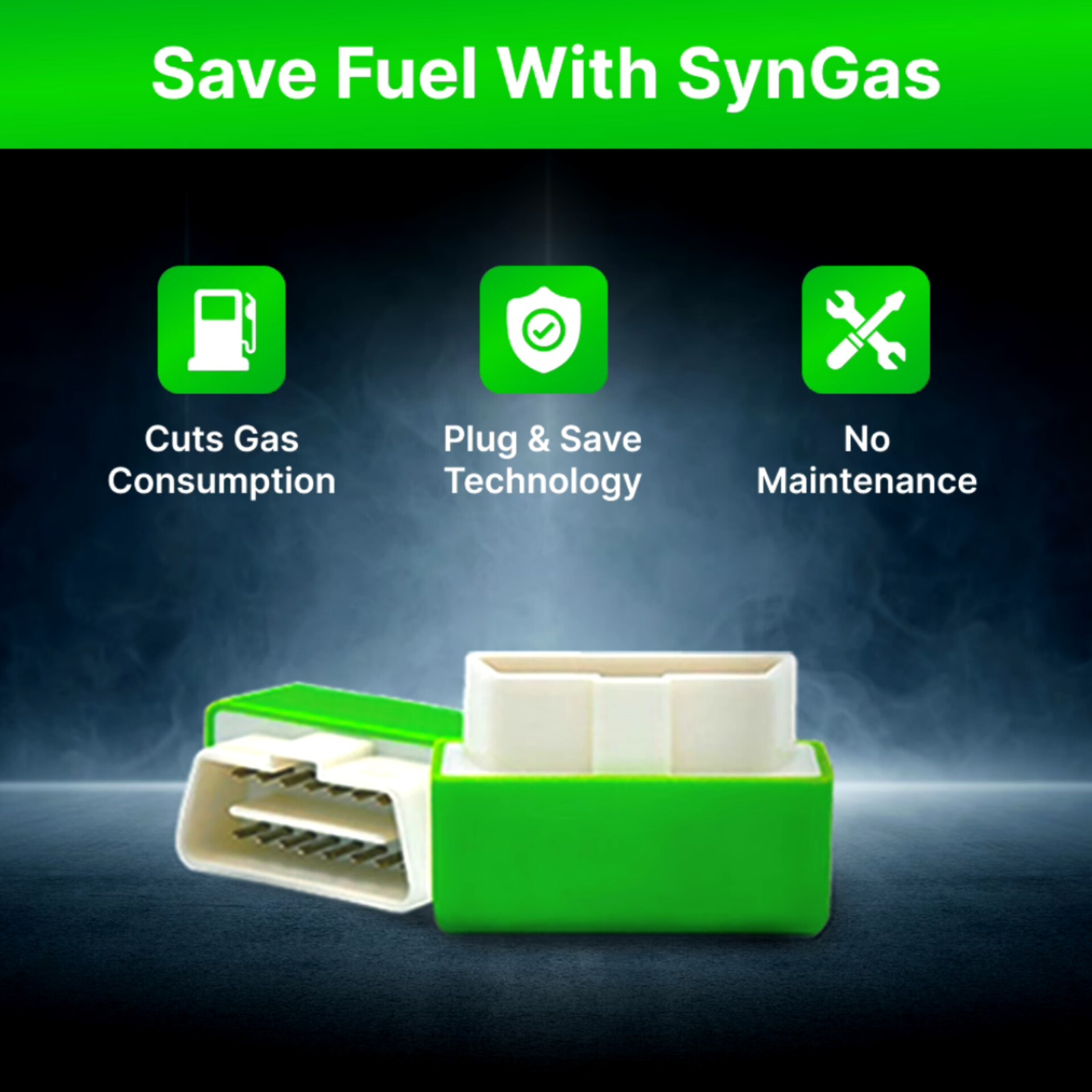Fuel prices continue to rise across the globe, and drivers are left searching for affordable solutions to cut down on daily expenses at the pump. This growing challenge has paved the way for innovative automotive technologies that promise to make vehicles more efficient and eco-friendly without costly modifications. Among these solutions, the SynGas OBD Fuel Saver has emerged as a product drawing attention for its bold claim of reducing fuel consumption by up to 55 percent.
Unlike traditional fuel additives, expensive mechanical upgrades, or hybrid conversions, this compact device plugs directly into a vehicle’s OBD2 port, requiring no advanced technical knowledge or tools. It is marketed as a smart calibration unit that works with a car’s onboard system to optimize performance while helping drivers spend less on gasoline. For many car owners, this concept feels both promising and refreshing because it offers a path to savings without disrupting how they use their vehicles.
In a time when efficiency and sustainability are at the forefront of conversations about driving, the SynGas OBD Fuel Saver positions itself as more than just a gadget. It appeals to anyone who wants to save money, reduce emissions, and extend the lifespan of their car’s fuel system. By promising results through a simple plug-in installation, it attempts to blend practicality with modern automotive technology.
The real question many drivers are asking is whether this compact device lives up to its claims. In this detailed review, we will carefully examine what the SynGas OBD Fuel Saver is, how it works, what sets it apart from alternatives, and whether it truly delivers value for money. Each section will provide an in-depth look at the product so potential buyers can make an informed decision before investing in it.
Understanding SynGas OBD Fuel Saver
The SynGas OBD Fuel Saver is a compact plug-in device designed to improve fuel efficiency by working directly with a vehicle’s onboard diagnostic system. Every modern car manufactured after 1996 comes with an OBD2 port, a standardized interface used by mechanics to read data from the engine and diagnose issues. This same port is what the SynGas device connects to, turning it into a gateway for real-time fuel optimization.
At its core, the SynGas OBD Fuel Saver is built to recalibrate certain functions of the car’s electronic control unit (ECU). The ECU is like the brain of the vehicle, constantly adjusting fuel injection, air intake, and combustion timing to maintain performance. The device claims to learn the driver’s unique habits over the course of a few hundred miles and then modify the fuel usage patterns accordingly. By doing so, it aims to cut down on unnecessary fuel consumption without compromising the smoothness of the drive.
Unlike fuel-saving myths such as magnets on fuel lines or liquid additives poured into the tank, SynGas takes a more data-driven approach. Instead of altering the chemical composition of fuel, it focuses on the digital signals that control how much fuel is burned in each cycle. This makes it an appealing option for car owners who prefer a non-invasive and maintenance-free solution.
The promise of up to 55 percent fuel savings is what makes the device stand out in a crowded market. While the exact results may vary depending on driving style, car model, and road conditions, the goal of the SynGas OBD Fuel Saver is to make cars run more efficiently on the fuel they already consume. For those who commute long distances or rely heavily on their vehicles for daily travel, the potential savings over time can be significant.
In essence, the SynGas OBD Fuel Saver positions itself as an affordable, easy-to-use, and smart technology that bridges the gap between modern driving needs and rising fuel costs. It doesn’t require complex installation, ongoing upkeep, or professional servicing. Drivers simply plug it in, let it calibrate, and continue driving as normal while the system gradually optimizes performance.
DON’T MISS OUT: SynGas OBD Fuel Saver Is Available At A Special Price – Click Here Now To Order Directly From The Official Website
Key Features of SynGas OBD Fuel Saver
When evaluating a fuel-saving product, the most important step is to look closely at what it offers and how those features translate into real benefits for everyday driving. The SynGas OBD Fuel Saver presents itself as a modern solution for fuel efficiency, combining simplicity, accessibility, and smart engineering. Below is an expanded breakdown of its most notable features and what they mean for drivers.
● Plug-and-Play Compatibility – One of the main attractions of the SynGas OBD Fuel Saver is its effortless setup. Designed for vehicles with an OBD2 port, it requires no mechanical expertise or extra tools. All a driver needs to do is locate the port, plug the device in, and start driving. This makes it far more user-friendly compared to other fuel-saving options that require engine modifications, software installations, or fuel additives. For anyone who values convenience, this feature alone makes it appealing.
● Intelligent Calibration Technology – Unlike static devices that make one-time adjustments, SynGas is programmed to learn. Over the course of approximately 150 miles or 240 kilometers, it observes driving behavior such as acceleration patterns, braking frequency, and cruising speeds. Using this data, it makes subtle recalibrations to the engine’s fuel consumption process. By tailoring its performance to each driver’s habits, the device aims to create lasting improvements in efficiency that feel natural rather than forced.
● Up to 55 Percent Fuel Savings – Fuel efficiency is the centerpiece of this device’s promise. The SynGas OBD Fuel Saver markets itself as being capable of reducing fuel consumption by as much as 55 percent. While results will depend on external factors such as the car’s make, engine condition, and traffic conditions, even a fraction of this figure can still amount to meaningful savings over time. For long-distance commuters or professional drivers, this feature has the potential to significantly reduce monthly expenses.
● No Maintenance Required – Another important feature is its maintenance-free design. The SynGas OBD Fuel Saver does not require refills, replacements, or frequent check-ups. Once installed, it quietly performs its function in the background without interfering with other components of the car. This hands-off approach makes it suitable for busy drivers who prefer not to deal with extra upkeep or hidden costs.
● Universal Vehicle Compatibility – Since the device is built for OBD2 systems, it is compatible with most cars manufactured after 1996. This wide applicability ensures that drivers across different vehicle types, from compact cars to SUVs, can use it without compatibility concerns. It also makes it a flexible purchase for households with multiple vehicles.
● Environmentally Friendly Operation – Beyond saving money, the SynGas OBD Fuel Saver indirectly reduces a car’s environmental footprint. By optimizing fuel use, it can lead to lower emissions, helping reduce the amount of carbon released into the atmosphere. For eco-conscious drivers, this dual role of saving money and promoting sustainability adds extra value to its features.
● Compact and Durable Build – The design of the SynGas device is small, lightweight, and durable. It blends seamlessly into the car’s system without drawing unnecessary attention or taking up space. This means drivers can leave it plugged in at all times without worrying about wear and tear or interference with other electronics.
In summary, the SynGas OBD Fuel Saver combines ease of use, smart learning technology, fuel reduction potential, and eco-friendly benefits in one compact package. Its features are designed to appeal to both cost-conscious drivers and those interested in sustainable driving solutions, making it more than just a typical fuel-saving gimmick.
Does SynGas OBD Fuel Saver Really Work or Just Hype
Every time a new fuel-saving technology enters the market, it is met with a mix of excitement and skepticism. Car owners want solutions that truly deliver on their promises, but they are also cautious because of the number of devices in the past that made bold claims without offering measurable results. This naturally raises the question: does the SynGas OBD Fuel Saver genuinely work, or is it just another hyped-up gadget?
The foundation of SynGas is different from many traditional fuel-saving products. Rather than relying on unproven gimmicks such as magnets on fuel lines or additives poured into the tank, this device works by communicating with the car’s onboard diagnostic system. By plugging into the OBD2 port, it gains access to the vehicle’s electronic control unit, which manages vital functions such as fuel injection, air intake, and combustion timing. This direct access to the car’s system is what makes its approach more credible.
The promise of up to 55 percent fuel savings is ambitious, and while real-world results will vary, the technology behind it has logical grounding. By analyzing driving behavior over the first 150 miles, SynGas fine-tunes how the car consumes fuel. Drivers who maintain consistent speeds, avoid sudden braking, and operate vehicles with well-maintained engines are more likely to see significant improvements compared to those with aggressive driving patterns.
Another aspect that lends credibility is its universal compatibility with cars manufactured after 1996. Vehicles built with OBD2 systems are already designed for digital diagnostics and adjustment, so a device like SynGas can integrate naturally. Unlike external add-ons that attempt to manipulate fuel flow physically, SynGas works within the boundaries of the car’s existing software and electronic signals, making it a safer and more realistic solution.
It is also worth noting that customer experiences reported for similar OBD-based fuel-saving devices often highlight improvements in efficiency when used over time. While not every driver may achieve the advertised maximum of 55 percent savings, even a modest reduction of 10 to 20 percent can result in noticeable monthly savings at the pump. Over the course of a year, this difference can add up to hundreds of dollars for daily commuters or drivers who log high mileage.
The skepticism mainly comes from the fact that results depend heavily on external factors such as vehicle condition, maintenance history, and driving habits. A poorly maintained engine or inconsistent driving style will naturally limit the device’s effectiveness. However, this is true of almost any fuel-saving method, not just SynGas.
In conclusion, while it may not deliver identical results for every driver, the SynGas OBD Fuel Saver cannot be dismissed as mere hype. It operates on a logical system-based principle, avoids unscientific shortcuts, and provides a pathway for measurable savings in real-world conditions. For drivers willing to let the device calibrate and continue driving consistently, it holds real potential to reduce fuel consumption and increase efficiency.
DON’T MISS OUT: SynGas OBD Fuel Saver Is Available At A Special Price – Click Here Now To Order Directly From The Official Website
Key Advantages of Using SynGas OBD Fuel Saver
When drivers consider investing in any automotive device, the ultimate question is what they stand to gain from using it. The SynGas OBD Fuel Saver sets itself apart by offering a range of practical benefits that go beyond just saving money at the pump. These advantages appeal not only to budget-conscious drivers but also to those who value convenience, efficiency, and sustainability. Here is an expanded breakdown of the most important benefits.
● Noticeable Fuel Savings – The most obvious and direct benefit of SynGas is the potential reduction in fuel consumption. With claims of up to 55 percent savings, the device positions itself as a long-term money-saving solution. Even if results vary from driver to driver, a consistent improvement in fuel efficiency can translate to fewer trips to the gas station and lower monthly expenses. For those who commute long distances or rely heavily on their vehicles for work, this becomes a practical financial advantage.
● Long-Term Cost Reduction – Beyond reducing fuel costs, the device can indirectly lower other vehicle-related expenses. By helping the engine burn fuel more efficiently, there is less strain on internal components over time. Efficient combustion can reduce carbon buildup, extend the lifespan of spark plugs, and improve the overall health of the engine. These benefits can save drivers money on future repairs and maintenance.
● Easy Integration into Daily Driving – Unlike fuel-saving methods that require altering one’s driving style or adding external substances, SynGas fits seamlessly into a driver’s routine. Once plugged in and calibrated, it operates automatically. Drivers don’t need to press extra buttons, monitor additional gauges, or make conscious adjustments. The convenience of having a passive system that works in the background is a major advantage for those who prefer hassle-free solutions.
● Environmentally Friendly Contribution – By optimizing fuel usage, the SynGas OBD Fuel Saver can help reduce harmful emissions. When less fuel is burned unnecessarily, fewer pollutants are released into the atmosphere. This makes it a suitable choice for environmentally conscious individuals who want to reduce their carbon footprint without switching to hybrid or electric vehicles. In cities with increasing environmental regulations, using such a device can align with sustainable driving goals.
● Universal Compatibility Across Vehicles – Since the device is designed for cars equipped with OBD2 systems, it works with most models manufactured after 1996. This broad compatibility makes it a versatile purchase for families with multiple vehicles or for individuals who may switch cars in the future. There’s no need to worry about brand-specific limitations or complex installation requirements.
● Maintenance-Free Design – Another standout benefit is the fact that SynGas requires no upkeep. Drivers do not need to replace filters, refill liquids, or perform system resets. Once installed, it can remain in the OBD2 port indefinitely, quietly carrying out its function. This maintenance-free approach saves both time and effort, which appeals to busy individuals.
● Peace of Mind with Support and Guarantee – For buyers hesitant about investing in new automotive technology, SynGas is backed by customer support and a money-back guarantee. This safety net gives drivers the confidence to test the product and see its results without fear of wasted money. The assurance of support and a refund policy reflects a level of accountability that not all products in this category provide.
In summary, the SynGas OBD Fuel Saver is more than just a fuel-saving device. Its benefits extend to cost reduction, ease of use, environmental sustainability, and long-term engine health. For drivers who want to cut costs while also supporting eco-friendly practices, it offers a package that is both practical and forward-thinking.
How SynGas OBD Fuel Saver Works
Understanding how the SynGas OBD Fuel Saver functions is key to determining its value. Many drivers hesitate when they hear claims of drastic fuel savings, but the mechanism behind SynGas is more grounded in modern automotive engineering than one might assume. Instead of changing the physical properties of fuel or requiring major modifications, it works through digital recalibration and data-based optimization.
The process begins with installation. Every car manufactured after 1996 is equipped with an OBD2 port, typically located near the steering column or beneath the dashboard. When the SynGas device is plugged into this port, it gains access to the car’s onboard diagnostic system. This system, also known as the ECU or engine control unit, is essentially the brain of the vehicle, overseeing vital operations such as fuel injection, combustion timing, throttle response, and airflow.
Once connected, the SynGas OBD Fuel Saver enters a learning phase. During the first 150 to 200 miles of driving, it observes how the driver typically operates the vehicle. It collects data on acceleration, braking, average speed, and fuel consumption. This information allows the device to recognize patterns and identify areas where fuel use can be optimized without affecting engine performance.
After this calibration period, the device begins to make subtle adjustments to the ECU’s fuel mapping. For example, if it detects unnecessary fuel injection during steady-speed driving, it can recalibrate the signals to ensure only the required amount of fuel is burned. Similarly, it can refine air-fuel ratio management to achieve more efficient combustion. These optimizations don’t alter the vehicle’s hardware or require mechanical intervention. Instead, they rely on electronic adjustments that are already supported by the car’s digital system.
What makes the SynGas system appealing is that it operates passively. Drivers do not have to monitor it or change their driving habits drastically. The device simply works in the background, continuously fine-tuning and maintaining adjustments as long as it remains plugged in. If removed, the car reverts to its default ECU settings, which means there is no permanent alteration to the vehicle.
Another layer of functionality is its universal adaptability. Because it works with standardized OBD2 systems, the same device can function across different car makes and models. Whether the driver owns a small sedan, a sports utility vehicle, or even a light truck, the principle of operation remains the same.
From a technical perspective, the device aims to strike a balance between performance and economy. Instead of simply cutting fuel flow, which could reduce power or smoothness, it targets areas of inefficiency. This is why some drivers report smoother acceleration, reduced engine strain, and improved mileage after extended use.
In short, SynGas OBD Fuel Saver works by leveraging existing automotive software capabilities. It uses real-time driving data to customize adjustments that lead to better fuel economy. It does not interfere with engine mechanics, making it a safe and reversible method for drivers seeking to reduce costs and emissions.
How to Use SynGas OBD Fuel Saver
One of the strongest points of the SynGas OBD Fuel Saver is how straightforward it is to set up and operate. Unlike other fuel-saving methods that require mechanical knowledge or repeated maintenance, this device is designed for everyday drivers who want simplicity. The process involves only a few easy steps, and once installed, the device does the work automatically in the background. Here is a complete explanation of how to use it.
● Step One: Locate the OBD2 Port – Every vehicle manufactured from 1996 onward comes with an OBD2 port. This is a small rectangular connection point usually located beneath the dashboard, near the steering wheel. In most cars, it can be found just above the pedals or slightly to the side of the driver’s seat area. In some vehicles, it may also be hidden behind a small plastic cover. No special tools are needed to access it.
● Step Two: Insert the Device – Once the OBD2 port is located, the SynGas OBD Fuel Saver can be plugged in directly. The fit is secure and does not require screws, wires, or additional installation steps. Drivers do not need the assistance of a mechanic because the device is designed to be plug-and-play.
● Step Three: Turn on the Ignition – After inserting the device, the next step is to turn the ignition key to the “on” position. For push-button vehicles, pressing the start button without stepping on the brake can achieve the same effect. This allows the device to power up and establish communication with the car’s electronic control system.
● Step Four: Begin Driving Normally – The device will begin its calibration phase during the first 150 to 200 miles of driving. During this time, it collects data on the driver’s habits such as speed patterns, braking style, and fuel usage. No changes are immediately noticeable because the system is in a learning mode. Drivers are advised to continue driving normally without attempting to alter their style just for the sake of calibration.
● Step Five: Experience Gradual Optimization – Once the calibration phase is complete, the device starts fine-tuning the fuel system. Drivers may notice gradual improvements such as smoother acceleration, more consistent mileage, and reduced trips to the gas station. The changes are not sudden or disruptive; instead, they integrate naturally into daily driving routines.
● Step Six: Leave It Plugged In – For the best results, the SynGas OBD Fuel Saver should remain connected to the OBD2 port at all times. Removing it will simply return the vehicle to its default settings, meaning the optimized adjustments will no longer be active. Because the device is compact and discreet, it does not interfere with normal use of the car or require constant attention.
● Step Seven: Optional Removal and Reuse – If a driver decides to move the device to another compatible vehicle, it can be unplugged and reinstalled without difficulty. The process will restart in the new car, with the calibration phase repeating to adapt to the new driver and engine conditions. This flexibility makes it a practical purchase for multi-car households.
In essence, using SynGas OBD Fuel Saver is a stress-free experience. It involves a single installation step, a short learning period, and ongoing automatic optimization. No tools, maintenance, or complicated instructions are necessary, making it one of the most accessible fuel-saving solutions available.
DON’T MISS OUT: SynGas OBD Fuel Saver Is Available At A Special Price – Click Here Now To Order Directly From The Official Website
Reasons to Consider Buying SynGas OBD Fuel Saver
There are several compelling reasons why drivers should consider adding the SynGas OBD Fuel Saver to their vehicles. The most obvious is the potential for meaningful fuel savings, with the device claiming to reduce consumption by up to 55 percent. Even if actual results vary, any consistent improvement in fuel efficiency translates to real financial relief, particularly for those who drive long distances or depend on their cars daily. Beyond direct savings, the device offers convenience because it requires no technical expertise or mechanical adjustments. Its plug-and-play design makes it accessible to all drivers, regardless of their automotive knowledge.
Safety is another important factor, as the SynGas OBD Fuel Saver does not interfere with the engine’s physical parts or pose risks of mechanical damage. Instead, it works through the vehicle’s onboard diagnostic system to make digital adjustments, ensuring reliable operation. Its versatility is also appealing since it is compatible with nearly all vehicles made after 1996. This makes it a flexible purchase that can be used across different cars within a household.
The benefits extend further, as reduced fuel consumption also lowers harmful emissions, allowing drivers to save money while making a small but positive contribution to environmental sustainability. In addition, by promoting more efficient combustion, the device may help reduce engine strain, improve smoothness, and extend the lifespan of certain components. For drivers who value peace of mind, SynGas also comes with customer support and a money-back guarantee, allowing them to test the product without taking on unnecessary risk.
Taken together, these reasons highlight why the SynGas OBD Fuel Saver is worth serious consideration. It addresses economic concerns, supports sustainable driving, and delivers a safe, user-friendly experience that makes it a practical choice for modern motorists.
Is SynGas OBD Fuel Saver Worth It
When evaluating whether the SynGas OBD Fuel Saver is worth buying, the discussion extends beyond just the upfront cost of the device. The true value lies in its ability to deliver measurable savings, improve long-term driving efficiency, and provide peace of mind to drivers who are weary of rising fuel costs. At first glance, the promise of up to 55 percent fuel savings may sound ambitious, but even partial improvements can quickly justify the investment. For example, a driver who spends hundreds of dollars monthly on fuel could potentially save a significant amount over the course of a year, offsetting the cost of the device many times over.
What makes SynGas particularly appealing is that it achieves this without demanding changes to a driver’s lifestyle or routine. Many fuel-saving tips require constant attention, such as altering acceleration habits, limiting air conditioning use, or driving at lower speeds. While those strategies may help, they are often inconvenient and unrealistic in everyday conditions. SynGas, by contrast, is designed to work in the background once installed, making it a more practical option for drivers who prefer seamless integration.
The non-invasive nature of the device also adds to its worth. Since it only interacts with the car’s onboard system and does not interfere with hardware, there is no risk of engine damage or warranty issues. This means the potential gains come without the worry of creating new problems. The fact that it can be reused across different vehicles further increases its value, especially for households with multiple cars or drivers who plan to switch vehicles in the future.
From an environmental standpoint, the SynGas OBD Fuel Saver also carries worth beyond financial savings. By reducing unnecessary fuel consumption, it helps lower emissions and supports cleaner driving. In a time where sustainability is becoming increasingly important, the device allows drivers to play their part without investing in expensive electric or hybrid vehicles.
When all factors are considered, financial savings, ease of use, environmental benefits, and long-term vehicle health, the SynGas OBD Fuel Saver positions itself as a product that delivers genuine value. While results may vary, and no device can promise identical outcomes for all drivers, the potential benefits far outweigh the modest cost. For anyone looking to stretch their fuel budget, reduce emissions, and adopt a more efficient driving experience, the SynGas OBD Fuel Saver is certainly worth it.
Customer Experience with SynGas OBD Fuel Saver
Drivers who have tried the SynGas OBD Fuel Saver often describe their experiences in terms of practicality and long-term results. Many users initially approach the device with caution, as fuel-saving technologies have a reputation for bold claims. However, those who install it correctly and allow it to complete the calibration phase tend to notice gradual changes over time. For some, this means fewer trips to the gas station, while others highlight smoother engine response and an overall improvement in daily driving.
One recurring observation from customers is the simplicity of the device. People appreciate that it does not require a mechanic or complicated installation steps. The ability to simply plug it into the OBD2 port and let it run in the background resonates with drivers who prefer low-maintenance solutions. Some users even mention the peace of mind of being able to transfer it from one car to another without any special adjustments, which makes it more versatile than many fuel-saving alternatives.
Of course, experiences vary. Certain drivers report significant fuel savings, while others notice more modest results. This variation is often linked to driving style, vehicle condition, and the type of journeys taken. For example, long-distance commuters who maintain steady speeds tend to benefit more compared to drivers who frequently face stop-and-go city traffic. Despite these differences, many agree that even small improvements in efficiency are worthwhile when accumulated over months of driving.
There are also positive remarks about the indirect benefits. Some customers feel that their cars run more smoothly, with cleaner acceleration and reduced engine strain. Others highlight the environmental aspect, expressing satisfaction that they are using less fuel and contributing in some way to reduced emissions.
Overall, customer feedback suggests that the SynGas OBD Fuel Saver works best for drivers who give it time to adapt and remain consistent with their driving habits. While expectations should be realistic, many users feel that the combination of ease of use, fuel savings, and environmental contribution makes it a valuable addition to their vehicles.
Is SynGas OBD Fuel Saver Safe to Use
Safety is often the first concern when considering any device that interacts with a car’s onboard system. Drivers want to save money on fuel, but not at the expense of their vehicle’s reliability or performance. The SynGas OBD Fuel Saver positions itself as a safe option precisely because it does not interfere with the physical mechanics of the engine. Instead of tampering with fuel lines, injectors, or combustion chambers, it operates entirely within the digital parameters of the car’s onboard diagnostic system.
Once plugged into the OBD2 port, the device begins its work by reading signals and gradually recalibrating fuel usage patterns through the electronic control unit. This process is not invasive and does not override factory settings in a permanent way. If the device is removed, the car simply returns to its default ECU programming. This reversible nature provides reassurance to drivers who may be worried about long-term impacts.
Another factor that adds to its safety is that it does not demand any additional modifications. Unlike aftermarket parts that require cutting, wiring, or engine tuning, SynGas leaves the car’s original design untouched. It does not alter emission control systems, disrupt sensors, or compromise warranties. This makes it a low-risk option for those who want to experiment with fuel-saving technology without committing to major changes.
The device is also built with universal compatibility in mind, designed for cars manufactured from 1996 onwards that use the OBD2 system. Because this system is standardized, SynGas works within established safety frameworks already built into modern vehicles. This reduces the risk of errors, conflicts, or malfunctions that might occur with non-standard devices.
User experiences also reinforce its safe reputation. Many drivers report that their vehicles run as smoothly with the device installed as they do without it. There are no signs of engine strain, no dashboard warning lights triggered, and no noticeable interference with normal performance. The optimization process is designed to be subtle, ensuring efficiency improvements are achieved without sacrificing reliability.
In summary, the SynGas OBD Fuel Saver is considered safe because it respects the boundaries of modern automotive design. It does not modify hardware, it is fully reversible, and it works within the digital ecosystem already provided by the OBD2 system. For drivers who value peace of mind alongside fuel efficiency, the device offers a reassuring balance of innovation and security.
Why SynGas OBD Fuel Saver Stands Out Among Alternatives
The market for fuel-saving solutions is crowded with options, ranging from liquid additives and magnetic fuel enhancers to aftermarket engine modifications. Yet many of these approaches either fail to deliver consistent results or introduce risks that outweigh the potential benefits. The SynGas OBD Fuel Saver differentiates itself by focusing on a digital, system-based method that integrates naturally with modern vehicles.
One of the biggest advantages over alternatives is its non-invasive design. Many fuel-saving devices require physical adjustments to the engine or fuel system, such as attaching magnets to fuel lines or pouring chemical additives into the tank. These methods often raise concerns about long-term engine health or warranty voids. By contrast, SynGas plugs into the OBD2 port and communicates directly with the car’s onboard diagnostics, avoiding any interference with physical components. This makes it both safer and more convenient.
Another area where it stands out is usability. Competing products often require ongoing maintenance—whether it’s buying refills, replacing filters, or reapplying treatments. SynGas requires no such upkeep. Once installed, it calibrates itself and continues to operate quietly in the background without demanding further attention from the driver. This maintenance-free approach adds long-term value that many competing products cannot match.
When compared to mechanical modifications, SynGas is also more cost-effective. Installing aftermarket chips, upgrading fuel injectors, or reprogramming the ECU can deliver performance improvements, but these upgrades are expensive, technical, and sometimes irreversible. SynGas offers a simpler, affordable option that achieves efficiency gains without the financial burden of professional tuning. If a driver wishes to stop using it, they can simply unplug it with no lasting impact on the vehicle.
Another distinction lies in compatibility. Many alternative products are tailored for specific car brands or models, limiting their usefulness. SynGas works universally with vehicles built after 1996, ensuring that a single device can benefit a wide range of drivers. This flexibility is particularly important for households with multiple vehicles or individuals who plan to change cars in the future.
Finally, SynGas emphasizes a balanced approach. While some devices promise extreme fuel savings but fail to deliver, SynGas is designed to provide gradual and realistic improvements that reflect actual driving patterns. By learning from the driver’s habits during the calibration phase, it creates personalized adjustments that alternatives often cannot achieve.
In short, the SynGas OBD Fuel Saver surpasses many competing products by offering a safe, maintenance-free, cost-effective, and adaptable solution. Rather than relying on outdated gimmicks or risky mechanical changes, it integrates with the car’s digital ecosystem to deliver practical results over time. This balance of innovation and simplicity is what makes it stand out in a crowded market of fuel-saving promises.
Is SynGas OBD Fuel Saver Worth My Money
When deciding whether the SynGas OBD Fuel Saver is a worthwhile investment, the most important question is whether the long-term benefits outweigh the initial cost. For most drivers, the answer depends on how much they spend on fuel each month, how consistently they drive, and what they expect from a fuel-saving solution.
From a financial perspective, even moderate fuel savings can quickly justify the purchase. If the device helps reduce consumption by 10 to 20 percent, which is a realistic outcome for many drivers, the savings over several months can already surpass the price of the device. For commuters who spend hours on the road each week, the cumulative effect is even more pronounced, making the purchase cost-effective within a short period.
Another reason it can be considered worth the money is the simplicity of ownership. Unlike additives that require repeated purchases or engine modifications that come with high installation costs, the SynGas OBD Fuel Saver is a one-time investment. Once installed, it works without further expenses, maintenance, or professional servicing. This means drivers can continue to benefit from it without worrying about ongoing financial commitments.
The value also extends to indirect benefits. More efficient fuel consumption reduces engine strain, which may help extend the life of spark plugs, injectors, and other components. Fewer repairs and smoother performance add another layer of financial relief. On top of that, by lowering emissions, the device allows drivers to contribute to environmentally friendly practices without the high cost of upgrading to a hybrid or electric car.
Of course, expectations should remain realistic. The device may not deliver the same level of savings for every driver, since results depend on factors like vehicle type, driving conditions, and maintenance history. But even modest improvements can still make a meaningful difference over time. For drivers who are consistently on the road, the small upfront cost can be recouped in just a few months of regular use.
In summary, the SynGas OBD Fuel Saver is worth the money because it offers measurable savings, requires no ongoing costs, and contributes to both financial and environmental goals. For those who drive frequently and want a simple, risk-free way to cut down on expenses, the investment can quickly prove valuable.
Pros and Cons of SynGas OBD Fuel Saver
Every product has its strengths and limitations, and understanding both sides is important before making a purchase. The SynGas OBD Fuel Saver presents itself as a practical and affordable option for drivers who want to reduce fuel expenses, but like any technology, it comes with both advantages and potential drawbacks.
On the positive side, the device offers impressive ease of use. Its plug-and-play design means anyone can install it within seconds without the need for technical knowledge or mechanical assistance. Once connected, it works automatically, learning the driver’s habits and optimizing fuel usage without requiring constant monitoring. This hands-free operation makes it accessible for all drivers, from daily commuters to occasional car users. The potential savings on fuel are another clear advantage. Even if the maximum claim of 55 percent is not achieved in every case, modest reductions of 10 to 20 percent still translate into meaningful long-term savings. Additionally, its universal compatibility with most cars manufactured after 1996 makes it a versatile solution that can be used across multiple vehicles. Environmental benefits also fall into the list of positives, as reduced fuel consumption leads to fewer emissions and a smaller carbon footprint.
On the other hand, there are a few limitations worth considering. The effectiveness of the device is not identical for every driver. Results vary depending on the condition of the vehicle, maintenance practices, and driving style. Aggressive driving habits or poorly maintained engines may prevent the device from showing significant improvements. Another potential drawback is the time required for calibration. Drivers must allow at least 150 miles of normal use before the device begins to make adjustments, which means results are not instant. For some, this waiting period may feel discouraging. In addition, while the device is marketed as universally compatible, certain vehicles with highly specialized tuning may not experience noticeable improvements.
In weighing these factors, the SynGas OBD Fuel Saver demonstrates more strengths than weaknesses for the average driver. Its convenience, cost-effectiveness, and eco-friendly advantages make it an appealing choice, provided expectations are realistic and drivers give it the time needed to adapt.
Who Should Consider Purchasing SynGas OBD Fuel Saver
The SynGas OBD Fuel Saver is designed with broad compatibility, but it is particularly well suited for certain groups of drivers who are likely to benefit the most from its features. Understanding who stands to gain the most from this device can help potential buyers decide whether it aligns with their driving habits and financial goals.
The first group that should consider this product is daily commuters. Individuals who spend hours on the road each week, driving to and from work, often face the highest fuel costs. For them, even modest reductions in fuel consumption can accumulate into significant yearly savings. Since commuting usually involves consistent driving patterns, the device has more opportunity to adapt effectively and deliver noticeable results.
Another ideal group is long-distance travelers. People who frequently take highway trips or drive across regions for business or leisure often consume large amounts of fuel. Because highway driving tends to be steadier than city traffic, the SynGas OBD Fuel Saver can optimize performance more effectively in these conditions, producing meaningful reductions in fuel use over extended journeys.
Fleet owners and professional drivers may also find strong value in this device. Taxi services, delivery drivers, and small business owners who operate multiple vehicles have high fuel expenses as a constant part of their operations. Using SynGas across a fleet can translate into large-scale savings over time, while also supporting environmentally responsible practices.
The product is also appealing to eco-conscious drivers. Those who care about reducing their carbon footprint but cannot afford to switch to hybrid or electric cars may find SynGas to be a practical middle ground. By optimizing fuel use and lowering emissions, it allows drivers to make a positive environmental contribution without the cost of upgrading to a new vehicle.
Finally, the device is suitable for budget-conscious families who own more than one car. Since it can be unplugged and reused across different vehicles, it offers flexibility and added value. Families that share cars or switch vehicles frequently can use the same unit to optimize fuel efficiency across their household’s transportation needs.
In short, the SynGas OBD Fuel Saver is best suited for commuters, long-distance drivers, fleet operators, eco-conscious individuals, and families looking to reduce expenses. While anyone with a compatible vehicle can use it, these groups stand to gain the most measurable benefits from the device.
Where to Buy and Pricing for SynGas OBD Fuel Saver
The SynGas OBD Fuel Saver is not a product you will usually find on the shelves of traditional auto shops or local gas stations. It is primarily available through online channels, where customers can purchase directly from the manufacturer’s official website or trusted retail partners. Buying from the official source is often the safest option because it ensures that customers receive an authentic device rather than a generic imitation. Official websites also tend to provide added advantages such as warranty coverage, customer support, and access to promotional discounts.
In terms of cost, the SynGas OBD Fuel Saver is marketed as an affordable one-time purchase. Unlike other solutions that require repeated refills or ongoing subscriptions, this device is bought once and can be used continuously. While exact prices may vary depending on promotions, many customers find it reasonably priced, particularly when weighed against the potential savings it generates over time. Purchasing multiple units often comes with bundle offers, which is especially useful for families with more than one vehicle.
The pricing structure usually reflects tiers, where single units are offered at a standard rate, but larger packages bring down the cost per unit. This allows buyers to maximize value, whether they are purchasing for themselves, their family, or even for use across several vehicles in a business fleet.
For most drivers, the key takeaway is that the investment is relatively modest compared to the recurring expense of fuel. By positioning itself as a cost-effective device with long-term benefits, the SynGas OBD Fuel Saver appeals to anyone seeking a balance between affordability and functionality.
DON’T MISS OUT: SynGas OBD Fuel Saver Is Available At A Special Price – Click Here Now To Order Directly From The Official Website
Frequently Asked Questions about SynGas OBD Fuel Saver
When considering a device that promises to save fuel, it is natural for drivers to have many questions. To help provide clarity, here are detailed answers to some of the most common inquiries about the SynGas OBD Fuel Saver.
How long does it take before I notice results with the SynGas OBD Fuel Saver?
The device needs time to understand your driving style and adapt to your vehicle’s system. On average, it requires around 150 to 200 miles of normal driving before adjustments begin to show. During this calibration period, you may not see immediate changes, but with consistent use, gradual improvements in fuel efficiency become noticeable.
Can I install the SynGas OBD Fuel Saver by myself, or do I need a mechanic?
You do not need a mechanic. The design of the device is intentionally simple, so anyone can install it without prior experience. All that is required is locating the OBD2 port, plugging the device in, and continuing to drive. The system does the rest automatically without any tools, wiring, or professional assistance.
Will it affect my car’s warranty or cause engine damage?
No, the SynGas OBD Fuel Saver does not tamper with the mechanical parts of your engine or make irreversible changes to factory settings. It works digitally through the onboard diagnostic system and can be removed at any time. Once unplugged, the vehicle reverts to its original ECU programming. This non-invasive nature ensures that warranties and engine safety remain intact.
Does the SynGas OBD Fuel Saver work on all vehicles?
The device is compatible with most vehicles manufactured from 1996 onwards that use the OBD2 system. This covers a wide range of cars, SUVs, and light trucks. However, older vehicles without OBD2 ports will not be able to use it, so it is important to confirm compatibility before purchasing.
Can I transfer the device between different cars?
Yes, one of the convenient features of the SynGas OBD Fuel Saver is that it can be unplugged and reused in another compatible vehicle. When moved to a new car, the calibration process will restart, adapting to the new engine and driving habits. This makes it a flexible option for households with multiple vehicles.
How much fuel savings should I realistically expect?
While the manufacturer claims savings of up to 55 percent, real-world results vary. Factors such as driving style, road conditions, and vehicle maintenance play a major role. Many users report moderate but consistent reductions, often in the range of 10 to 20 percent. Even at this level, the device can generate noticeable monthly and yearly savings.
Does the SynGas OBD Fuel Saver require ongoing maintenance?
No maintenance is required. Once installed, it continues to operate in the background without refills, updates, or replacements. Drivers only need to leave it plugged into the OBD2 port to maintain the benefits. If removed, the car reverts to its default settings without issue.
Can it be used in both petrol and diesel cars?
Yes, the SynGas OBD Fuel Saver is designed to work with both fuel types as long as the vehicle uses an OBD2 system. Whether you drive a gasoline-powered sedan or a diesel SUV, the device functions in the same way by optimizing the electronic signals that manage fuel consumption.
Final Thoughts on SynGas OBD Fuel Saver
The search for affordable and reliable ways to cut down on fuel expenses has never been more important. Rising fuel prices place a constant burden on drivers, and many so-called solutions on the market either underdeliver or create risks that outweigh their benefits. Against this backdrop, the SynGas OBD Fuel Saver positions itself as a practical option that blends modern technology with user convenience.
What makes this device appealing is its simplicity. With a straightforward plug-and-play design, it removes the need for technical expertise or costly mechanical modifications. Once installed, it quietly adapts to the driver’s habits and begins optimizing fuel usage in the background. For those who prefer solutions that do not interfere with their daily routines, this convenience is one of the strongest reasons to consider it.
The potential for long-term savings is another point in its favor. Even modest reductions in fuel consumption can add up to substantial financial relief over the course of months or years. Drivers who cover long distances or maintain steady commuting schedules are especially positioned to benefit. Beyond financial gains, the environmental contribution is equally important. By helping vehicles burn fuel more efficiently, the SynGas OBD Fuel Saver can reduce emissions, allowing drivers to play their part in sustainability efforts without investing in expensive new vehicles.
Of course, expectations must remain realistic. The device’s effectiveness varies depending on factors such as vehicle condition, driving style, and road conditions. It is not a magic solution that guarantees maximum savings for every driver. Instead, it should be viewed as a supportive tool that, when used consistently and under the right conditions, delivers practical improvements.
In conclusion, the SynGas OBD Fuel Saver is a product that brings together affordability, safety, and convenience in a single package. For drivers seeking a low-maintenance way to reduce fuel costs, protect their engine from unnecessary strain, and make driving more eco-friendly, it represents a valuable investment. While results will differ, the balance of benefits makes it a sensible choice for those looking to stretch their fuel budget without sacrificing comfort or reliability.
DON’T MISS OUT: SynGas OBD Fuel Saver Is Available At A Special Price – Click Here Now To Order Directly From The Official Website





























